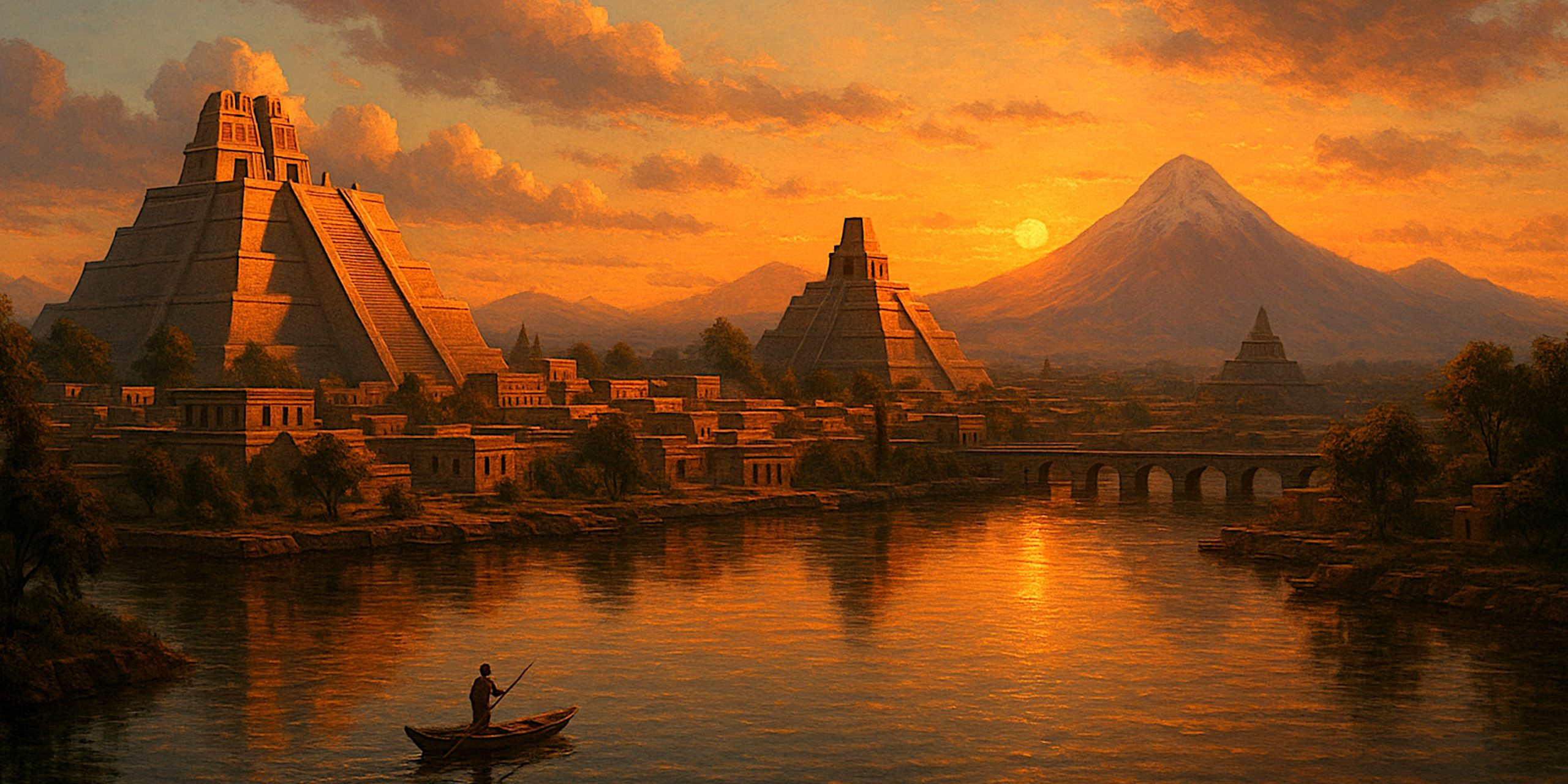
Few civilisations evoke such fascination and misunderstanding as the Aztec Empire. Rising from the marshy valley of Mexico in the 14th century, the Mexica built a powerful, sophisticated state that blended artistry, ritual, and imperial ambition. Yet much of what people think they know about the Aztecs is filtered through colonial accounts, sensationalised tales, and half-remembered school lessons.
As a historian, it is difficult not to feel both awe and frustration when confronting the myths that have buried their true achievements. So, let us strip away the exaggerations and look at seven verified facts and seven myths that still haunt the story of the Aztec world.
7 Facts about the Aztec Empire
1. The Aztecs Built Their Capital on a Lake
Tenochtitlan, the heart of the empire, was constructed on artificial islands within Lake Texcoco. The city was a marvel of engineering, featuring canals, causeways, and aqueducts that made it one of the most advanced urban centres of its time. When the Spanish first saw it, they compared it to Venice.
2. They Had a Structured and Merit-Based Society
Despite the rigid hierarchy, Aztec society allowed mobility. Warriors skilled with Aztec weapons, merchants, and artisans could rise in rank. Education was also universal, with schools for both nobles and commoners, a rarity in the 15th century world.
3. The Empire Was a Military and Economic Powerhouse
The Aztec Triple Alliance, Tenochtitlan, Texcoco, and Tlacopan, expanded through both warfare and diplomacy. Conquered cities paid tribute in goods such as cacao, feathers, and gold, which kept the empire’s economy flourishing.
4. Agriculture Was Highly Innovative
The Aztecs transformed shallow lakebeds into chinampas, or floating gardens, producing vast quantities of maize, beans, and squash. This system fed a population that may have exceeded 200,000 in Tenochtitlan alone.
5. Religion Was Central to Every Aspect of Life
The Aztecs believed in maintaining balance between the gods and humanity. Their ceremonies, offerings, and festivals were not acts of cruelty but expressions of cosmic duty. Religion shaped law, art, and even warfare.
6. Their Written Language and Records Were Complex
Aztec scribes used pictographs and phonetic symbols to record events, lineages, and tribute lists on deerskin or bark paper codices. Though many were burned by the Spanish, surviving examples remain vital to our understanding of Mesoamerican history.
7. Tenochtitlan’s Fall Was a Mix of War, Disease, and Betrayal
The Spanish conquest of 1521 was not simply a tale of European superiority. It involved tens of thousands of Indigenous allies, internal rebellion, and devastating waves of smallpox that crippled the Aztec resistance.
7 Myths about the Aztec Empire
1. Myth: The Aztecs Called Themselves “Aztecs”
The term “Aztec” was coined centuries later. They called themselves Mexica, and their empire was known as the Triple Alliance. The name “Aztec” comes from Aztlán, the mythical homeland from which they believed they had migrated.
2. Myth: They Were Mindlessly Bloodthirsty
Human sacrifice existed, yes, but it was ritualised and symbolic. It represented renewal and reciprocity with the gods, not senseless brutality. Many early Spanish reports exaggerated these practices to justify conquest and conversion.
3. Myth: The Aztecs Believed the Spanish Were Gods
Cortés was not universally mistaken for the god Quetzalcoatl. This story emerged from later European narratives. Contemporary Indigenous sources suggest that Moctezuma recognised the Spanish as powerful foreigners, not divine beings.
4. Myth: The Aztecs Were a Primitive or Isolated People
Far from it. The Mexica inherited and expanded on centuries of Mesoamerican knowledge. They traded across vast distances and built on the cultural legacy of Toltec and Maya civilisations.
5. Myth: The Empire Was a Monolithic State
It was more of a tribute network than a unified nation. Local rulers retained autonomy as long as they paid tribute and supplied warriors. This system, while efficient, also made the empire vulnerable to rebellion when the Spanish arrived.
6. Myth: The Spanish Easily Defeated the Aztecs
The conquest was brutal and prolonged, lasting two years of sieges, starvation, and attrition. The Spanish relied heavily on Indigenous alliances and superior naval control of the lakes around Tenochtitlan. It was a coalition victory, not a simple conquest.
7. Myth: The Aztec Civilisation Vanished After the Conquest
The fall of Tenochtitlan did not erase the Mexica. Their descendants continued to live in the region, adapting under colonial rule. Nahuatl, their language, is still spoken by over a million people in Mexico today.
The Seven Swords Takeaway
The Aztec Empire was neither a savage relic nor a flawless utopia. It was a civilisation of contradictions, brilliantly creative yet bound by cosmic duty, militaristic yet artistically profound. The myths that surround it often say more about colonial bias than about the Mexica themselves.
To study them honestly is to acknowledge their ingenuity, resilience, and the enduring cultural heartbeat that still echoes through Mexico’s language, art, and identity today.



